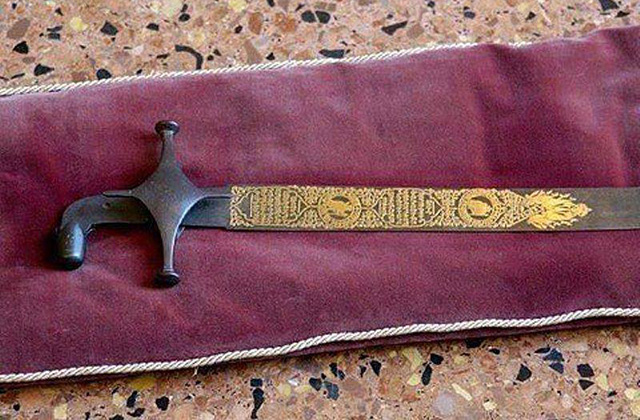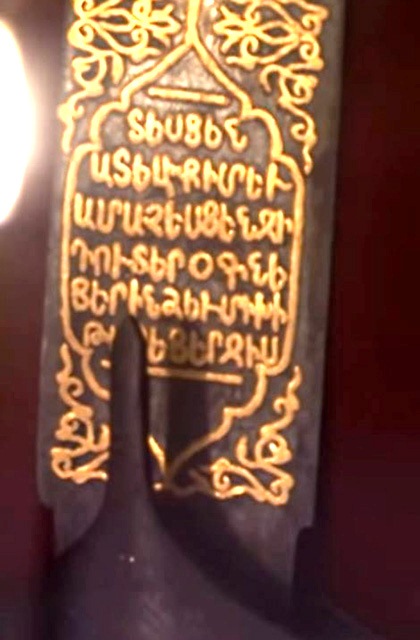
Vexed Gulbenkian and the King’s Sword

Armenian well-known writer Yervand Otian has a story written in 1898. It’s called “Sword of King Levon.” The story is about the friends, who visit the National Historical Museum (Athens) to see the sword of King Levon V of Lusinyan family of Kilikia Empire. And then the author writes, “It was not for the first time I saw that sword. It was a dagger with gilded exquisite scabbard, on which it was carved in Armenian: King Levon and a date. That sword was made by an Armenian craftsman from a market in Constantinople, then as I was told, it was sold for good money to an Englishman, gathering old items. Then the Englishman gave it to the Museum as a gift. And it was laying in the corner since then…”
As we know, the history has a feature of repeating. Almost four decades later after the story was published, something happened, which would really surprise Otyan, if he were alive. It happened in 1935. On that year 1000th anniversary of Persian writer Ferdowsi was being celebrated in the Soviet Union. Miscellaneous events have been organized everywhere, and “Hermitage” of Leningrad wasn’t an exception. A Persian exhibition was launched in the Museum. And there was someone quite unexpected among the honored guests—an Armenian millionaire, philanthropist and art lover Calouste Gulbenkian. Presence of capitalist Gulbenkian in a proletarian country, and even as a guest, was really an exclusive case. However, it had its own reasons. When the soviet state was in need and had to exhibit well-known pieces of art for sales, Gulbenkian became one of the buyers, paying good money for dozens of canvases.
However, his presence in “Hermitage” in 1935 wasn’t conditioned by that circumstance only. The point is, the rich Armenian possessed a big collection of historical items of Sasanyan era, and brought some samples to Leningrad for the exhibition. And here he met representatives of Armenian delegation. The meeting was rather warm. They were touching upon the country’s ongoing situation, future plans. And Gulbenkian promised the Armenian scientists to support History Museum of Armenia not only financially, but all to donate from his collection historical items with Armenian roots.

A few months later they received the promised package. In the note it was being informed that it was the sword of King Levon. The donor was also informing that the sword was purchased from the Museum of Mkhitaryan Congregation in Venice. Employees of the History Museum started to examine the exclusive gift. It was a weapon having the form of Caucasian dagger, with ivory handle, on which the well-known carving of King Levon was observed, and the sheathe was covered with leather. However, after listening to the conclusion of the experts, the joy turned into a disappointment. The sword was fake. The experienced Gulbenkian has also been cheated.
He should know about that. A letter was sent to London from the Museum. In the letter they thanked him for the kind attitude, however, stating that the gift couldn’t have belonged to the King of Kilikia. Then lasting silence followed it. The response wouldn’t come. And nobody knows how the donor perceived that disappointing news. It’s only worth mentioning that after that case the Museum didn’t get the promised financial assistance, neither it got the exhibits. Calouste Gulbenkian seemed to be deeply disappointed. But from whom? Maybe he didn’t forgive himself, that being a connoisseur of history and arts, he naively swallowed the bait.

However, it’s worth returning to the fate of the Kilikia King’s weapon, which has continuation. It’s difficult to guess why it was decided to forge the sword of King Levon. It should only be stated that there was no lack of royal swords. Likewise cases have been repeatedly recorded. Thus, Vardan Hatsuni yet in his “History of old Armenian Taraz” (1923) was describing the sword of King Levon and was regarding it as simple forgery. Another sword appeared in Echmiadzin Historical and Ethnographical Museum. It was being told that the sword was rather big, made of Damascus steel, and a code was carved on it, which seemingly would edify its belonging to Levon V. However, it was a fake as well. Another forged sword was found in the museum of the Armenian church in Paris. Even its appearance was betraying on its reference to Armenian armaments. And today there is another well-known sword in the Museum of St. Lazaro Island.
By Hovik Charkhchyan


















